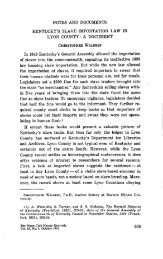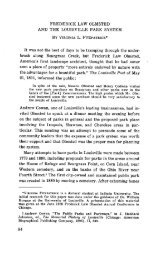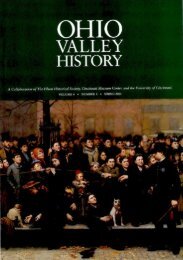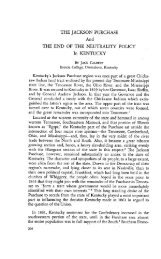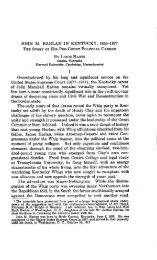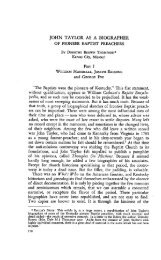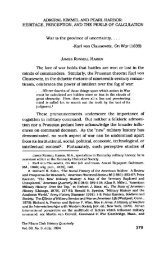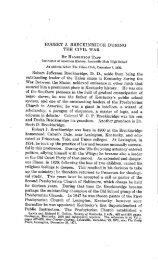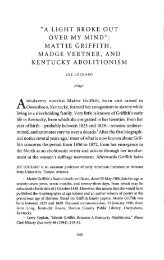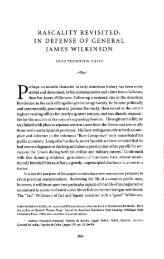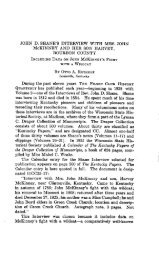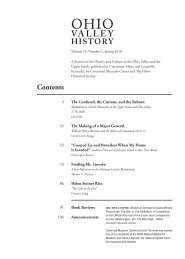Himlerville: Hungarian Cooperative Mining in Kentucky - The Filson ...
Himlerville: Hungarian Cooperative Mining in Kentucky - The Filson ...
Himlerville: Hungarian Cooperative Mining in Kentucky - The Filson ...
Create successful ePaper yourself
Turn your PDF publications into a flip-book with our unique Google optimized e-Paper software.
1992] HimlerviUe 533<br />
the summer for adults. Even<strong>in</strong>g classes <strong>in</strong> English and American<br />
history were taught for residents too old to attend the public<br />
schools.6°<br />
More <strong>Hungarian</strong>s wanted to move to Mart<strong>in</strong> County than<br />
<strong>Himlerville</strong> could accommodate. In the 1920s there was a wait<strong>in</strong>g<br />
list of 1,500 people <strong>in</strong> the United States and <strong>in</strong> Hungary who<br />
wanted to come to <strong>Himlerville</strong>. <strong>The</strong> wait<strong>in</strong>g list was long because<br />
<strong>Himlerville</strong> was an attempt to create a little Hungary <strong>in</strong><br />
a corner of Appalachia. In Mart<strong>in</strong> County the immigrants found<br />
a land rich <strong>in</strong> m<strong>in</strong>eral resources that provided abundant economic<br />
opportunity for poor peasants. <strong>The</strong> hills of eastern <strong>Kentucky</strong><br />
rem<strong>in</strong>ded the <strong>Hungarian</strong>s of their native land. Officials<br />
of the Himler Coal Company were aware that the powerful homemak<strong>in</strong>g,<br />
landown<strong>in</strong>g <strong>in</strong>st<strong>in</strong>cts with<strong>in</strong> the European peasant attracted<br />
immigrants to <strong>Himlerville</strong> because of a desire to rema<strong>in</strong><br />
close to the land. <strong>The</strong> urban lifestyle most immigrants experienced<br />
<strong>in</strong> American Cities alienated them from the land. Because<br />
<strong>Himlerville</strong> enabled <strong>Hungarian</strong>s to rema<strong>in</strong> attached to the land,<br />
most immigrants who came to <strong>Himlerville</strong> <strong>in</strong>tended to rema<strong>in</strong> <strong>in</strong><br />
eastern <strong>Kentucky</strong> permanently. S<strong>in</strong>ce <strong>Himlerville</strong>'s residents<br />
owned the ground upon which their houses stood, they, unlike<br />
immigrant m<strong>in</strong>ers <strong>in</strong> other southern Appalachian coal camps,<br />
did not move from m<strong>in</strong>e to m<strong>in</strong>e because of dissatisfaction with<br />
company control with<strong>in</strong> the camps, prejudice, or work<strong>in</strong>g conditions.<br />
Although Himlerv<strong>in</strong>e was an attractive community, life was<br />
nonetheless difficult for its residents. <strong>The</strong> <strong>Hungarian</strong>s Often had<br />
to endure racial prejudice and discrim<strong>in</strong>ation. Native mounta<strong>in</strong>eers<br />
perceived the immigrants as be<strong>in</strong>g <strong>in</strong>ferior to everybody<br />
but the Negro and frequently called <strong>Hungarian</strong>s "hunkies," or<br />
"hunks." <strong>Himlerville</strong> was known throughout Mart<strong>in</strong> and surrotmd<strong>in</strong>g<br />
counties as "Hunkie Town," "Hunkieville," or "Little<br />
60 Chapman, "Influence of Coal," 232; Bagger, "Himler,'" 187.<br />
61 <strong>Kentucky</strong>, Department of M<strong>in</strong>es, Annual Report, 1922, p. 286.<br />
62 Bagger, "Himlcr," 187.



